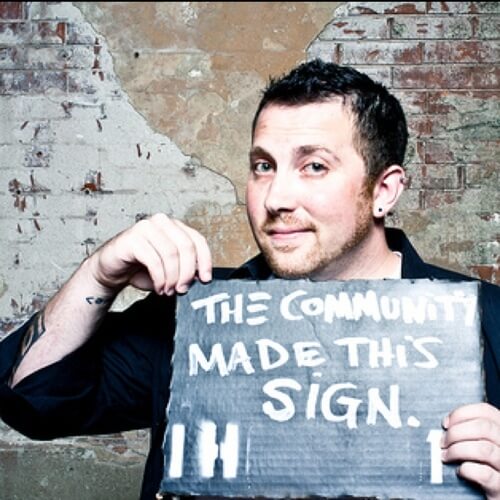“My name is Harvey Milk, and I’m here to recruit you” That’s a war cry, if I ever heard one. Over the weekend, I sat down to watch Milk, a documentary about the life story of Harvey Milk as the first openly gay public official.
The story of Harvey’s work for the gay rights movement is inspirational in itself. Unfortunately, I don’t think I’ll be going into the details of that here since I really, really want people to go see the movie.
What I do want to mention is the importance of Harvey’s technique for tactically inspiring, motivating, organizing, and mobilizing a community to action and making things happen.
I really think that four step process, in cycles, is a powerful technique and worth reflecting on.
And that’s why we’re here, right?
1. Inspire
Harvey’s first step was to take a step at all. Given his groundbreaking goals, making any forward motion was inspiring in itself. He failed at being elected to office, and he failed more than once. His persistence and attitude attracted like-minded movers and shakers. Some of those movers and shakers came with momentum of their own. Others were movers and shakers with potential. Harvey wasn’t discriminating towards either. Anne Kronenberg had prior campaign experience, and was an organizer herself. Others, like Cleve Jones, had less experience with formal community mobilization but Harvey knew that he had potential, and more importantly, knew how and when to put Cleve in opportunities to show that potential.
As a community organizer, your first move to action is to not be alone. Inspire those around you, and gain some critical mass. From that critical mass, identify new blood to continue recruitment and spreading of the message.
2. Motivate
So you’ve got a critical mass. You’ve got well spoken, active, passionate partners in your mission. Don’t sit on that.
Be daring. Do the unexpected. In the movie, Harvey led an impromptu demonstration of thousands of gay residents of the Castro in San Francisco the night that Dade county ban on gays in schools was being voted on. He led them to the point of near riot, and then demonstrated his ability to take control of, and channel the energy of, the mob with little more than his voice. It was the aftermath of these actions that set off the chain reaction that Harvey needed to motivate the rest of his potential supporters into being supporters, and his existing support became even stronger as they watched the groundswell around them.
As a community organizer, your second action is to show people the tools, and then give them the tools. Every follower should look to you and say, “I can do that, too”. And then your response should be, “yes, of course you can”.
3. Organize
This is where Harvey really shone. His every action became tactical, utilizing the relationships he’d forged. But the key to his organization was a sub-point to organization, and that was delegation. He knew his strongest disciples, and when and where he could rely on them. As you’re organizing, take the “smallest pieces” approach. Take your goals and tasks and break them down until they are approachable and achievable, and then hand them out.
Here’s the kicker: by making sure that the goals you’re handing out are approachable and achievable, you’ve created situations where the people in your community that you’ve inspired and motivated have a chance to win. Once they feel that win, they’re quickly hungry for more, and come back ready to take what they learned from their first win and get that adrenaline rush again.
“But what if they fail?”. Good. That’s almost better than a win. Since you’ve broken these goals into such small pieces, they’ll fail quickly. They will learn lessons. And most importantly, others will learn those lessons as well.
As a community organizer, your third action is to organize, but not micromanage. Delegate goals. Reward success with new goals. Reward failure with education. There’s far more to be learned from failure than there is from success.
4. Mobilization
This is actually much simpler than most people think, especially if you’ve followed this far.
You’ve already got people circled around a common vision. You’ve already got people inspired, and inspiring one another. You’ve already got goals broken out, and organizationally set yourself up for a win (and an easy recovery from a loss).
Now go somewhere. All mobilization is, is taking your plan to action. Pick a point of reference, and have everyone focus on it at once. In a tactical sense, this is when all of the soldiers lock onto the same set of targets and pull their triggers at the same time.
As a community organizer, your fourth action is to provide a point of reference, and lock on. Fire when ready.
Repeat
Every time you think you’re done, that’s just an opportunity to repeat the cycle. The beautiful thing about this cycle is that each time it repeats itself, its impact is larger than the former time around. You’ve got more people who can inspire, motivate, organize, and mobilize. Each effort spun off only leads to more efforts that spin off. Communities grow so that they can fracture, and continue growing. That’s how communities work. It’s a good thing.
As a community organizer, your final action is to never have a final action. Do it again.
And that was how Harvey Milk got elected to public office.
And that was how Harvey Milk took on the John Briggs campaign.
And that was how Harvey Milk led a community to become a movement.
 I am always thinking about the intersection of people, relationships, trust and business. I founded
I am always thinking about the intersection of people, relationships, trust and business. I founded